A young knight returns from the Crusades and finds himself entangled in some rather nasty business when rival knights go on a kidnapping spree. Fortunately, he has some help from King Richard and Robin Hood.
It’s not a question of where he grips it, it’s a simple matter of weight ratios!
I must confess myself to being something of an Ivanhoe fangirl. I was fifteen when I decided to go on a course of self-improvement and fill in the classic novels that I had missed reading. Being a bit of a medieval buff since pretty early in my childhood, Ivanhoe was at the top of the list. An 1820 publication date, 1,000 pages in the first edition. Reader, I fell head over heels.

I realize that Ivanhoe is not to everyone’s taste but I do encourage you to give it a shot. It’s not about the plot (a big mistake many modern critics make when bashing it) but rather about the atmosphere, the recreated medieval pageantry. It’s a book that enfolds you and completely takes over your senses and it is intensely quotable. There are fewer names more fun to say than Sir Brian de Bois Guilbert. I’m not going to pretend it is light or easy but I do think it is well worth the effort. (I recommend the audiobook narrated by James Cosmo. Audiobooks can make heavy literature more accessible and reading books aloud was popular family entertainment for centuries, so you are even historically accurate if you adopt this method.)
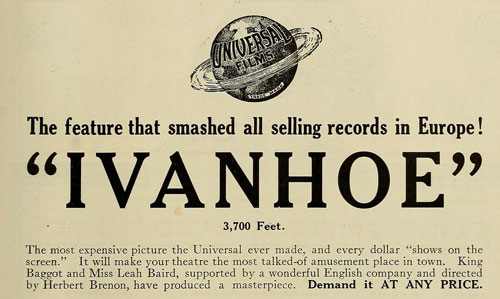
In the aftermath of my Ivanhoe reading, I became a bit of an adaption nerd. I sought out every version I could (not easy when the internet was so young) but I was never able to see the 1913 Universal release. Until now. So, this is quite an occasion for me, a fun revisit of a teenage hobby. The print is held in the Netherlands and all the title cards are in Dutch but those familiar with the story should have little trouble following the action and if you are not yet acquainted with Ivanhoe, here is a handy and detailed synopsis of this film version.
Pre-WWI, American film companies had seized on location filming as a way to attract attention and give their productions a sheen of class. The most famous world travelers were probably the Kalem crew, who shot films in Ireland, Egypt and the Holy Land. Universal wanted a piece of that lucrative prestige film pie and so it shipped off a film crew to capture Ivanhoe on film surrounded by real castles.

In this case, Chepstow Castle was the destination and main setting for the studio’s adaptation of Ivanhoe. Surrounded in medieval scenery, the story unfolds in a manner that is not so much adapted as it is amputated.
I’m not going into a full synopsis of Ivanhoe the novel because, well, this review doesn’t need to be the size of a Volvo. I’ll just make mention of a few of the cut scenes and other changes to the original and we should all be home by supper. Deal? Deal.
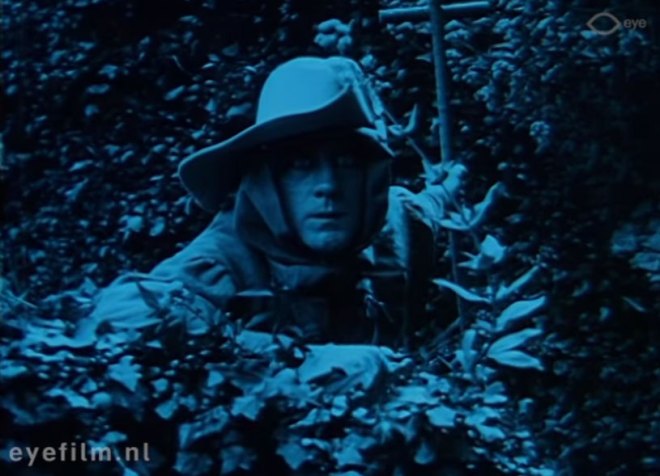
The film opens with a Palmer (King Baggot) calling on Lady Rowena (Evelyn Hope, who later married Boris Karloff). He has a message from her love, Wilfred of Ivanhoe, the disinherited son of her guardian. Of course (nudge nudge, wink wink) the Palmer is really Ivanhoe in disguise but everyone is nearsighted and glasses would spoil that medieval mood so he goes about undetected, though his armor is hidden under his robes and gives him a decidedly lumpy appearance.
Cedric (Wallace Bosco) and Rowena sit down to dine when they find themselves with two sets of guests. First, some Norman knights who are clearly up to no good. They are Reginald Front de-Boeuf (Jack Bates) and Brian de Bois Guilbert (Wallace Widdicombe), the latter of whom is a Templar.
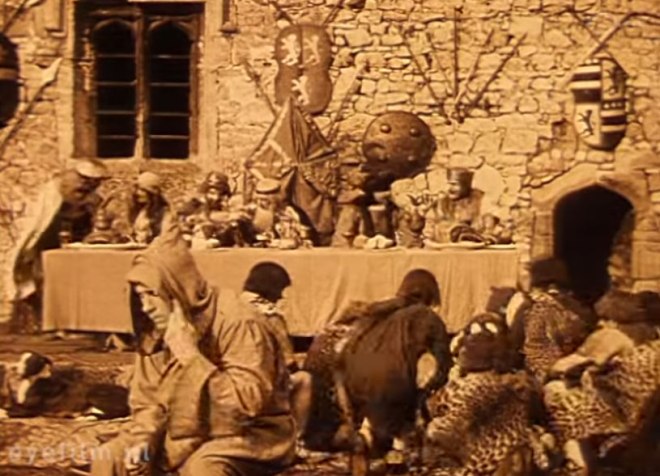
Okay, I am now going to make the confession that I have failed as a viewer, reviewer and history nerd. I try my best to give movies a fair shake and base my assessment of their successes and failures on comparisons of other similar films of the period. So far, so good. But the problem is that the costumes and facial hair in Ivanhoe look so similar to those of certain characters in Monty Python and the Holy Grail that I found myself quoting the dialogue as the film played and giggling like mad. I’M SORRY, OKAY?
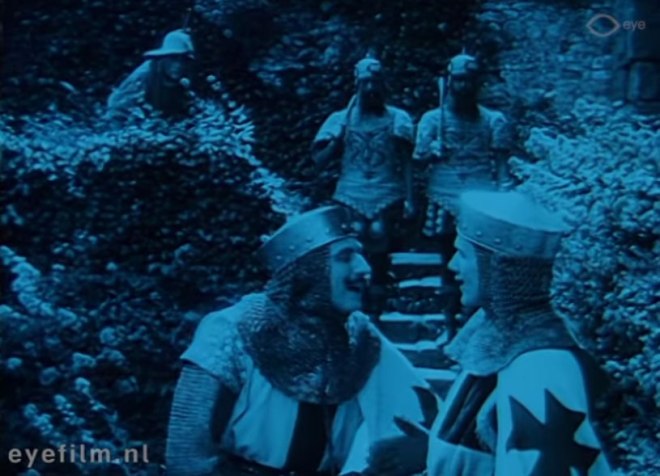
I was all right until the Norman knights showed up but their mustaches made them look so much like the insulting French that I couldn’t help myself. “Your mother was a hamster and your father smelt of elderberry!” If it in any way restores my reputation, let me tell you that at least one reviewer of the day complained about “German military moustaches” on the Normans.
Anyway, the other guests are Isaac of York (Herbert Brenon) and his daughter, Rebecca (Leah Baird). Bois Guilbert immediately gets all lecherous and schemes with Front de-Boeuf to commit infamous acts of abduction, theft and anything else he can think of. Ivanhoe overhears, tries to escape with Isaac and Rebecca (“Nice seeing you, dad and Rowena!”) but is slashed apart rather thoroughly by the Normans, who proceed to kidnap everybody.

Now this doesn’t exactly set up our hero in a particularly flattering light and I do wish the tournament scenes from the novel had not been cut as they would have established Ivanhoe as a force to be reckoned with (the tournament was the source of his wounds), as well as introducing the whole King Richard/Robin Hood thing. Yep, the novel is something of a who’s who in medieval legend and is responsible for much of the modern interpretation of Robin Hood. (The Douglas Fairbanks version really should have given Scott co-writing credit.)
Plus, you get delicious lines of dialogue like this exchange between Brian de Bois Guilbert and Ivanhoe:
“Have you confessed yourself, brother,” said the Templar, “and have you heard mass this morning, that you peril your life so frankly?”
“I am fitter to meet death than thou art” answered the Disinherited Knight; for by this name the stranger had recorded himself in the books of the tourney.
“Then take your place in the lists,” said Bois-Guilbert, “and look your last upon the sun; for this night thou shalt sleep in paradise.”
“Gramercy for thy courtesy,” replied the Disinherited Knight, “and to requite it, I advise thee to take a fresh horse and a new lance, for by my honour you will need both.”
Yes! That is what I am talking about! (My younger brother and I used to play the Ivanhoe Game, the object of which was to open to random passages and see who could deliver the dialogue is a more grand and regal manner.)
But nooooo, we don’t get a tournament and I am properly peeved. I really such things would have been expensive but Universal had already shipped everyone off to England. In for a penny, in for a pound. Sigh. Also, it would have given the story some much-needed breathing room because as it stands, Ivanhoe is dashing around to save the lives of a couple of people he just met whereas in the book, he owes his life to Rebecca’s prowess as a healer.
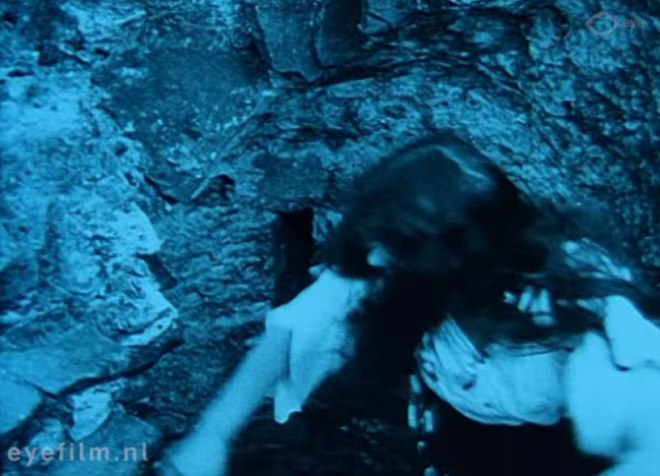
So, Cedric and Rowena and later Isaac and Rebecca are captured and held in Torquilstone Castle. Isaac is rather graphically tortured by Front de-Boeuf in order to oblige him to turn over his fortune. Rebecca is chased around by Bois Guilbert and the claustrophobic nature of the old castle’s passageways add considerably to the suspense of the situation. There’s also some reasonable snappy editing and cross-cutting between the prisoners and Ivanhoe’s rescue plan.
His rescue plan is as follows: Get King Richard and Robin Hood to help him storm the castle. (Say it, you know you want to.) What follows is the Pretty Much the Reason This Film Was Made scene with armies of extras playing the opposing sides and waving assorted medieval cutlery at one another. It’s pretty darn impressive for 1913, even if the fight choreography is not exactly John Woo. If the story is true, King Baggot was smashed severely on the head during one of these melees.

According to the Exhibitors’ Times:
“Among all the bruises, scratches and cuts for the foundry hands, under the urging of the enthusiastic director, laid on right merrily and with many a cracked crown, the most serious came to the star, King Baggot. In the finish of the light, when he had the enemy on the run, he received a tremendous blow on the head, a blow which may have been intended to settle a grudge in the foundry. It found the wrong mark, and so savage was it that the actor realized that he must lose consciousness. But it was not on the cards for the victorious Ivanhoe to faint at the time, and so it must not be. Weak, dizzy and half out of his wits, he, nevertheless, kept his head, and his feet as well, until he saw the operator drop the handle. Then, when the picture was taken and the necessity of acting over, he fainted dead away.”
For what it’s worth, Baggot does indeed seem to be staggering at one point during the battle.
(Spoiler from here, I think, but the book is almost 300 years old.) Everyone is rescued except for Rebecca, who is kidnapped by Bois Guilbert, taken back to Templar HQ and accused of being a witch. Ivanhoe simply will not have that and he heads out to defeat the Templar in single combat. Rebecca has been crushing on Ivanhoe but he ends up with Rowena. The end!
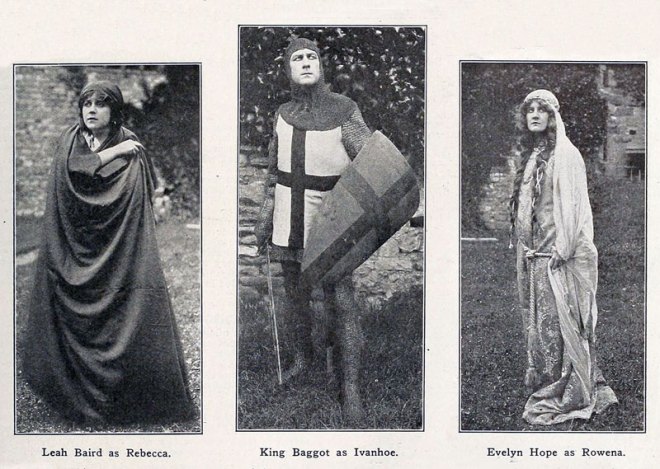
The cast of Ivanhoe seems to be playing things a bit dramatically by the standards of their day in order to compete with the scenery and do justice to the rather flowery prose of the original novel. Some of it works, some of it doesn’t. At least the performers show a bit more spunk than the overall staid cast of From the Manger to the Cross (1912), the other big overseas American production of the period. This dedication to BIG acting would have certainly been a conscious choice and would have been expected by audiences of the period.
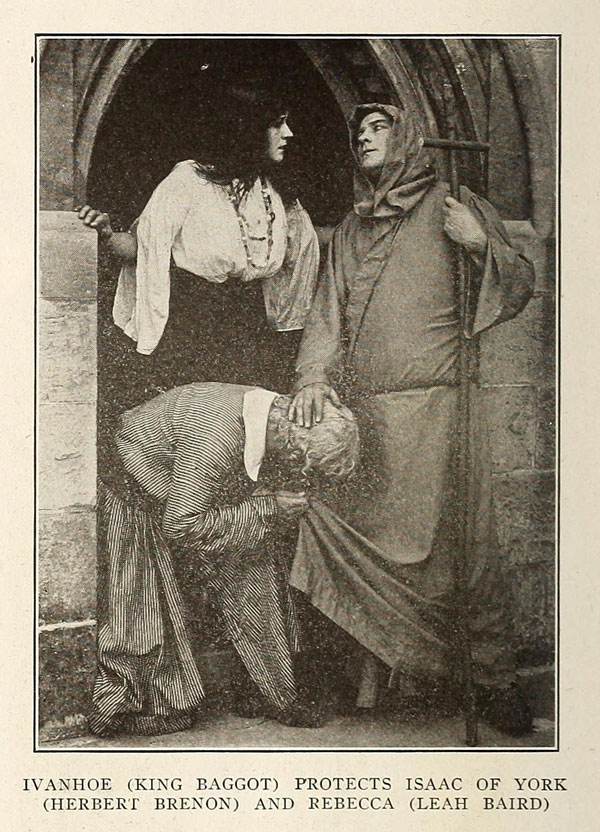
King Baggot, who would later turn his hand to directing, does a lot of the dramatic pose stuff and generally acts like he is being fitted for a new suit of armor. I liked him better when he was actually in motion during the motion picture. Evelyn Hope and Wallace Bosco have so little to do that they practically count as cameos.
Herbert Brenon as Isaac does carry on a bit and I do wish the director had reigned him in. The director was one (scans page) “Herbert Brenon”… Oh. Brenon would later find greater success as a director with credits that include the 1926 version of Beau Geste, the first screen version of The Great Gatsby and Laugh, Clown, Laugh.

I must say, though, that I was quite disappointed in the way the film handles Sir Brian de Bois Guilbert. I have always considered him one of the more interesting villains of classic literature but he is reduced to a mustache-twirling (and what a mustache) cad and bounder here. I mean, don’t get me wrong, Bois Guilbert was not a nice man but his inner workings in the novel were fascinating. A religious hypocrite who cannot conceive of anyone else being sincere, his inability to deny himself leads to his death and very nearly kills the one person he claims to love. That’s some good stuff!
Alas, the film has him turn into a plain, average rotter. In the book, he is horrified when Rebecca is charged as a witch but cannot quite figure out a way to extricate her. In the film, he is the one who condemns her to burn. Mwahahaha, etc. Wallace Widdicombe furthers the problem by playing him like the landlord about to foreclose on a poor, wee widow and her seventeen starving children.
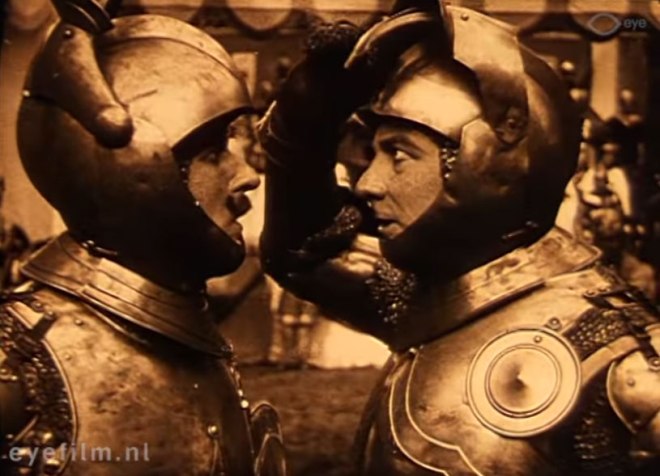
Poor Leah Baird (who later found success as a screenwriter and specialized in bringing women’s issues to the screen) is not given much to work with as Rebecca. She basically spends the entire film fending off a masher and isn’t given any time to show why everyone is so in love with her. Her standoff with Bois Guilbert is put on fast-forward and never quite sparks like it should.
The film ends with Rebecca and Isaac departing and Ivanhoe reunited with Rowena. For years, the fact that Ivanhoe did not end up with the far more interesting Rebecca has been a subject of controversy. William Makepeace Thackeray penned a satirical novel called Rebecca and Rowena that indulged everyone’s favorite pre-Victorian shipping.
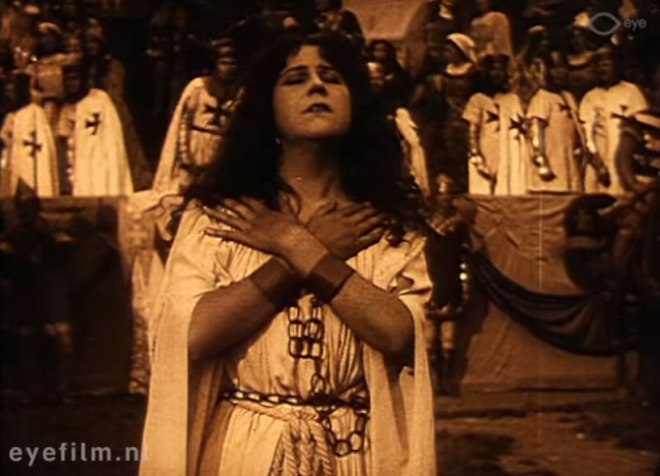
As in the case of shipping Professor Higgins and Eliza Doolittle in the space between Pygmalion and My Fair Lady, I feel that the basic argument rather disregards Rebecca’s agency and treats her like a prize for the hero. After all, what could Ivanhoe, as dull as Rowena, bring to the marriage? There’s only so many times one needs to be rescued from being burned at the stake. Further, it would have forced her to convert and that would have been profoundly disappointing. (For an example of this NOT working, I refer you to the 1927 film Surrender in which the Jewish heroine ends up with the Cossack prince who had previously threatened to burn her village to the ground.)
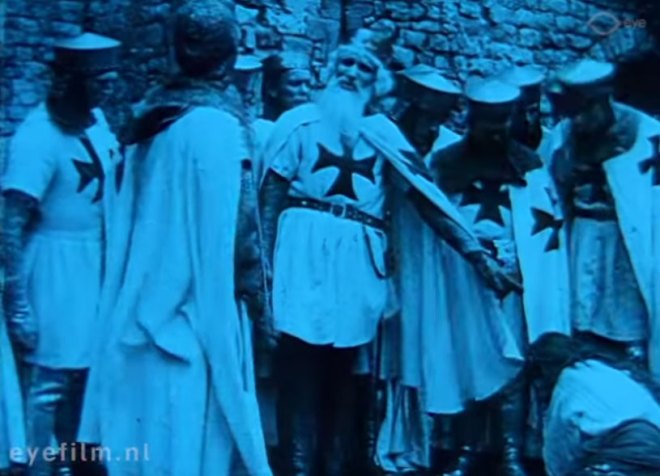
I must concur with Edgar Rosenberg’s opinion published in From Shylock to Svengali: Jewish Stereotypes in English Fiction: “Historically the marital problem could have been solved in the way Scott’s predecessors solved it, and as Thackeray solved it in his parody, by allowing Rebecca to submit to baptism. In that case she would have compounded the venial sin of bombast with the mortal sin of hypocrisy, and her function in the novel would have lost what meaning it has. She has to stick it out with her father, if only to make good her protests and act out her creeds. The only way in which Scott could have eaten his cake and had it too would have been to recruit Ivanhoe for the synagogue.”
Which would have been AWESOME. Personally, I prefer to believe that Rebecca got over her crush on old Wilfred and met an absolutely gorgeous fella in her travels (played by Joseph Schildkraut, rawr) and found happiness with her intellectual equal.
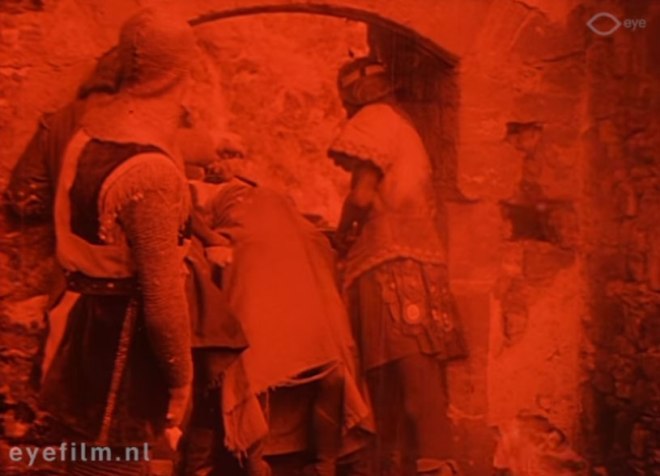
This, of course, leads to a discussion of how Jews are portrayed in the novel and whether or not it can be considered anti-Semitic. To cut to the chase, Scott condemns the anti-Semitism faced by Isaac and Rebecca but he also indulges in the ethnic tropes and stereotypes that have been used to excuse said anti-Semitism. (There’s a good gathering of the various opinions on the topic in the New English Review here.)
For example, here is a scene in the novel in which Isaac is considering giving Ivanhoe’s lackey Gurth a coin for his troubles:
“Here the Jew paused again, and looked at the last zecchin, intending, doubtless, to bestow it upon Gurth. He weighed it upon the tip of his finger, and made it ring by dropping it upon the table. Had it rung too flat, or had it felt a hair’s breadth too light, generosity had carried the day; but, unhappily for Gurth, the chime was full and true, the zecchin plump, newly coined, and a grain above weight. Isaac could not find in his heart to part with it, so dropt it into his purse as if in absence of mind.”
Yeah… So, I am pretty comfortable labeling Ivanhoe a problematic favorite. Rebecca is a pretty splendid heroine in the old school romantic style but Isaac’s Scrooge McDuck ways cannot really be defended, nor should they be. It’s a blot on a book that I love, I am aware of its flaws and open to reading about and discussing them while still reading the novel. A friend of mine cannot read it because of this content and that is absolutely his right.

The film, for what it is worth, does not go this route with the character. Both Isaac and Rebecca and Cedric and Rowena are portrayed as victims of the Normans with the Jewish characters being subjected to far harsher treatment. There is no pocketing of plump coins or other unfortunate behavior assigned to Isaac.
For all its flaws, the film does look the ticket. I don’t mean that its exactly accurate to its 11th century setting (heck, the novel was famously inaccurate) but rather that it translates the 1913 view of medieval England to the screen successfully. Ivanhoe is often inaccurately labeled as a Victorian novel (its actual publication date was 1819, the year Victoria was born) but it did enormously influence the Victorian view of medieval times, chivalry and they were portrayed in the pop culture of the day.

The picture was a hit and was brought up in movie magazines for years afterward, its tenth anniversary celebrated at Universal and some sources listing it as King Baggot’s film debut. (It wasn’t.) Alas, the First World War put a stop to much location filming and the movies headed to California, which provided much variety of scenery even if it lacked authentic medieval castles. That’s what hanging minatures and mattes are for, I suppose.
Ivanhoe has the glorious realness that we can only find in silent films of this period. It’s kind of like how for Hell’s Hinges, when they needed a town to be burned down, they built a town and burned it. When they needed a ship battle for Ben-Hur, they built ships and set fire to them on the Mediterranean. It was expensive and dangerous but mad props to the silent era filmmakers for doing it. The pictures still look great after all these years, which is more than can be said for some modern CGI.

(I suppose I should be upset that the castle did not burn in the movie as it did in the novel but, hey, it was rented and I imagine the owners would have been slightly peeved and Universal would have lost their cleaning deposit.)
This is not the perfect Ivanhoe but then again, I don’t think the perfect Ivanhoe has ever been made. I didn’t like the 1952 film even before I read the novel (Elizabeth Taylor seems curiously unconcerned about being potentially burned), the 1997 miniseries tries too hard with the “We’re MODERN! We’re NINETIES!” schtick and just comes off as sadistic in its violence, the 1983 Russian film The Ballad of the Valiant Knight Ivanhoe looks splendid but has a score seemingly played on a Commodore 64 and—more significantly—cuts Rebecca from the story entirely.
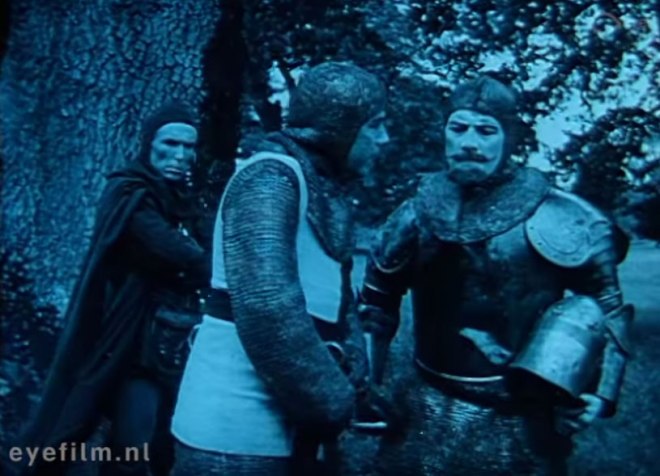
I’ll have to give the Best So Far But That’s Not to Say It’s a Masterpiece™ medal to the 1982 TV version starring Anthony Andrews, Olivia Hussey and Sam Neill as Ivanhoe, Rebecca and Bois Guilbert respectively. It’s not perfect by any means and a lot of good stuff is cut but the essentials are right and that’s evidently all we can hope for. (It’s apparently a tradition of some thirty years to watch this film on New Years Day in Sweden. The tradition has been described as “bizarre” by some news outlets but couldn’t just about every tradition be seen as bizarre? In any case, I would rather watch Ivanhoe than the interminable Ten Commandments every Easter—and I LIKE Cecil B. DeMille. You do you, Sweden, and enjoy.)
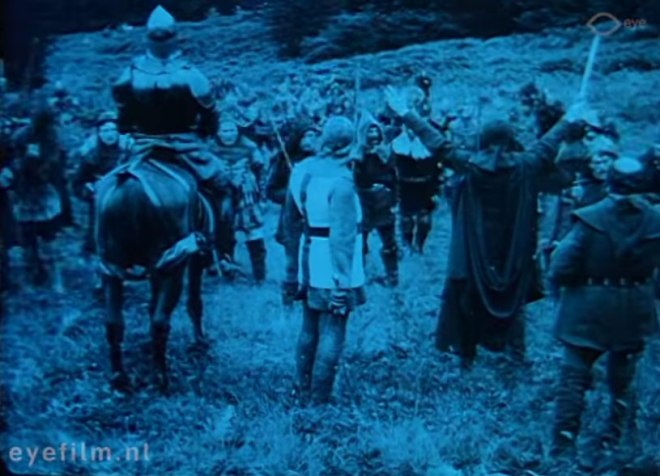
So, I mean, it’s not like the 1913 version is paling in comparison to modern rivals or anything. In fact, as stated above, the picture has much to recommend it.
Ivanhoe is no masterpiece but it is interesting from a historical perspective. From a moviegoing perspective, there are quite a few chinks in its armor and the emphasis of spectacle over the characters is a fatal flaw. Herbert Brenon shows improvement as a director but the scenario is just too much “and then everyone hit everyone else” to properly showcase the central conflict. Worth seeing with some caveats.
Where can I see it?
Available on YouTube for free and legal viewing courtesy of the EYE Filmmuseum. The titles are NOT in English and it doesn’t have a but the image quality is great. I hope it gets a proper release someday with a suitably epic score.
***
Like what you’re reading? Please consider sponsoring me on Patreon. All patrons will get early previews of upcoming features, exclusive polls and other goodies.

King Baggot was originally from St. Louis. Local film critic & historian Tom Stockman, did a King Baggot Tribute at the St. Louis International Film Festival in 2014 and another at the Missouri History Museum in 2016. I attended the 2016 event. They showed Ivanhoe at both of these events accompanied by The Rats and People Motion Picture Orchestra. It was the beautifully tinted print from the EYE Filmmuseum. The producers of the event had English titles made for the presentation. Tom also presented a lecture on Baggot’s life and career. It is really a shame that so very few of his films survive and that he is not better known.
Here is one of the blog posts that Tom did for the 2016 event.
http://www.wearemoviegeeks.com/2016/09/story-king-baggot-first-king-movies-begins-st-louis/
I was a bit confused by the sudden appearance of Robin Hood, but I enjoyed the film immensely.
Yes, the sudden appearance of Richard and Robin Hood is one of the main problems with eliminating the book’s tournament scene. There’s only so much you can trim from a 1,000 page book before you hit bone.
Fritzi, there is something wrong here. According to the IMDb (admittedly not the most reliable source) the woman named Evelyn Hope who married Boris Karloff was born in 1904. That would have made her nine years old when this version of “Ivanhoe” was made. I think this is a case of two women with the same name being confused with one another.
Well fiddle dee dee, I will have to double check and see.
I actually knew a man named King Baggot when I lived in Studio City CA. He and his partner owned The Party Shop (long shuttered) that used to be THE place for quality and imported party goods of every sort. King told me his mum named him after her matinee idol from the silent cinema. King and Jim had a beautiful antique Ivanhoe novel always displayed in one corner of the shop window next to an autographed photo of Baggot. Ah, memories… Thanks so much for your wonderfully comprehensive review of the 1913 Ivanhoe! Now off to view it on youtube!!
I’ll bet there would have been quite a few little Kings of a certain age given his popularity. 😉
Enjoy Ivanhoe!
This brings back a lot of memories. We read Ivanhoe when I was in high school so I remember the names and situations even though my high school days were a very long time ago. (I’m in my 80s now).
When you said the book was nearly 300 years old I think you meant 200 years.
It would have been a fun school assignment. Alas, I was in school when the teachers decided to be all arty and demand that we read books about dead dogs or kids. I don’t remember if I was able to wrangle some credit for my Ivanhoe reading or not, I should think it would be worth a few grade points.
Oops! That will teach me to type up a review with a tiny kitten trying to walk across my keyboard.
I DID enjoy the heck out of it! What a great shoot location, Chepstow Castle (1913 potential audiences would have noted the prominent billing advert of an authentic location, as you said, no doubt adding considerably to drawing power). Just have to look into Chepstow’s origins extensively now, perhaps via Time Team’s multiple sites, my forever go-to places for all things medieval. Thanks so much again for this review 🙂
Yay! Yes, that’s quite a proper medieval castle if there ever was one. I am glad they opted not to burn it down. 😉
Thanks for another enjoyable and informative review. I quite liked the film, but thought it was nothing special – probably because, like you, I’ve seen so many versions, some of which were better. And in my case, when I was very young, I loved the Ivanhoe television series starring Roger Moore. It was probably terrible, but I was only 5 or 6 when it was shown in Australia, and I loved a tale of derring do in those days. Have you ever come across it?
Thank you! Yes, this is a fun movie to watch even if it isn’t quite the Ivanhoe ticket. I haven’t seen the series but I should check it out as I am rather fond of Roger Moore and I am quite curious to see how they turned it into something for kids. Looks like a takeoff of the old Robin Hood show, yes?
Very much a response to Robin Hood, and there was a Sir Lancelot around as well at about the same time. I think Ivanhoe may have been an attempt by one of the US networks to match the success of whichever competitor was showing Robin Hood. I have just realised that I can remember some of the theme song! From memory, it really just used the characters of Ivanhoe and Gurth, but had little relationship to the book, other than the very romanticised 12th century setting. And it may not have been Roger Moore’s finest hour – sorry if he disappoints!
No worries, I have an extremely high tolerance for this kind of thing. I watched almost no contemporary television growing up and most of of my viewing was classic cliffhanger serials so I know what I’m in for. I do wonder, though, what made the producers look at an infamously dense book about religion, politics, hypocrisy and sex and say “Yes! For the kids!” 😉
You’re right about the Monty Python similarities. I watched Monty Python and the Holy Grail many times as a young adult, and I had a definite “ahah” moment when you broke out the stills from the Ivanhoe silent. The stills are SO much like the Python movie, right down to the angle the knight holds his head. What do you want to bet, one of them had this movie on 16 mm and watched it 500 times when they were a kid until they wore out the print?
That or they saw stills in a picture book. My money would be on those little medieval nerds Terry Jones and Michael Palin. Anyone who writes a skit based on an Icelandic saga… 😉
Ivanhoe was shown in Walsall for a week,shared between the Imperial Hall and the Electric Picture Palace. It’s described as “a free adaptation”. The odd thing is that the two cinemas were not connected in any way and wouldn’t normally share films.
As for the tv series Ivanhoe, we also had “Sir Lancelot” and ” Sir Francis Drake”.
I can see “Lancelot, Lancelot!” for a theme in the “Robin Hood, Robin Hood riding through the glen” genre but I wonder how “Sir Francis Drake” went. To me, it has more of the rhythm of a tarantella. 😉
Sadly, I don’t recall the Francis Drake theme, but, even more sadly, I do remember the words to Robin Hood, Sir Lancelot and William Tell. We also had “Richard the Lionheart”.
I heard a story that I really hope is true about a bride wanting to walk down the aisle to the “Robin Hood song” meaning the Bryan Adams ballad from the Kevin Costner version. But the organist was old school and, you guessed it, when the bride appeared…
“Robin Hood, Robin Hood,
Riding through the glen,
Robin Hood, Robin Hood,
With his band of men”
It’s not easy to deal with the ethics of old arts. I don’t think we should censor history or historical attitudes that we don’t accept, but anyway, romantic art of kings, beautiful princesses and heroic noblemen is a bit difficult. I can tolerate their birthrights as a historical fact in more realistic arts, but glorifying them romantically can easily spoil my film or book experience. Reading Lord of the Rings at the age of 11 was absolutely fantastic, but reading it again as an adult was a mistake. Ivanhoe belongs to the great childhood memories, which I don’t want to spoil by repeating my mistake with LOTR. Since Rebecca was clearly the most fascinating character of Ivanhoe, which is surprising considering how old the book is, I don’t think racism would my biggest obstacle with it.
It’s definitely sometimes disappointing to visit old childhood favorites.